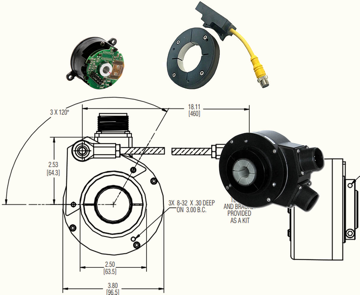Draw Wire Encoder Overview
A draw-wire encoder is a linear measuring device that consists of a spring-wound cable reel with a rotary encoder mounted on the hub of the reel. The cable is attached to a load which draws out the wire as the reel turns causing the encoder to rotate and transmit the amount of rotation either as a voltage pulse stream (incremental encoder) or digital word (absolute encoder). Alternatively, output can also be provided as an analog linear voltage output or even as output from a resolver.

Draw Wire Encoders Terminology
Draw wire encoders are also commonly known as draw string encoders or string pot encoders, after a previous configuration known as a string potentiometer. Draw wire encoders are compact, easy to mount, and highly portable. They are tough, making draw wire encoders good solutions for environments like shop floors, manufacturing lines, and off-road vehicles. Common applications include telescoping cranes and industrial equipment like forklifts, oil and gas drilling equipment, and wood- and stone-working machines.
Other alternative names for draw wire encoders in addition to draw string encoders include rope-length transmitters, rope-length transducers, cable-length transducers, and yo-yo encoders after the way the spring-wired drum pulls the wire back when it is removed from the load.
Operating Principles of Draw Wire Encoders

The basic operating principle of a draw wire encoder is simple; a rotary encoder is coupled to a spring loaded-reel using a mechanical coupling device, internal to the housing of the reel. A cable is wound around the reel, usually a metal braid type. The braided cable is anchored to the drum of the reel and wrapped many times around it. The opposite end of the cable passes through an exit port of the draw wire encoder housing and is terminated with an anchoring device such as a clevis or loop to attach to the moving mechanism being measured. As the cable is pulled, the drum is rotated and the linear motion is translated into rotary motion, at which point the draw wire encoder encodes the information into an electric signal. In simplistic terms, the concept of a draw wire encoder can be likened to a fishing reel.
However, unlike the fishing reel analogy the drum is spring loaded to eliminate cable slack and therefore ensure accurate length measurement. Depending upon the linear distance being measured and the diameter of the draw wire encoder drum and cable, a multi-turn absolute encoder is used to provide a true absolute measurement over the entire range of the linear motion. Draw wire encoder measurement lengths can range from a few inches to tens of feet.
Learn how to measure linear distance with draw wire encoders here
Key Parameters of Draw Wire Encoders
- Measurement Length: The maximum potential travel of the cable which will determine the lengh of the cable reel
- Accuracy: how closely the output of the encoder matches the real physical distance being measured
- Linearity: the consistency of distance between each increment/bit for the linear output of the encoder
- Resolution: the smallest increment the system can measure. For draw wire encoders, this will be determined by the smallest increment of linear measurement desired
- Repeatability: how effectively the system repeats the results of the same measurement
- Environment: Dust, moisture and temperature will determine the enclosure IP rating and temperature requirement
It is important to note that the accuracy and repeatability of the draw-wire encoder as a system is not the same as the accuracy and repeatability of the encoder itself. Mechanical issues introduced by improper installation and alignment can compromise both operation and measuring performance. Learn the difference between encoder resolution, encoder accuracy and repeatability here
Drawbacks of draw-wire encoders
Draw-wire encoders are largely mechanical devices, so they suffer from many of the same error sources and failure modes as typical mechanical components. Both wire hub and encoder have frictional components that require regular lubrication and maintenance. The wire stretches over time, causing measurement error to drift.
Pay attention to duty cycle when considering a draw-wire encoder. They provide a good solution for a measurement or two per day but would not be recommended for the use case that requires them to move back and forth repeatedly throughout a shift. Because the assemblies are dependent upon lubrication, very cold temperatures can introduce error.



